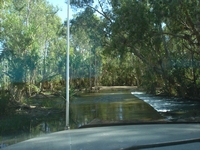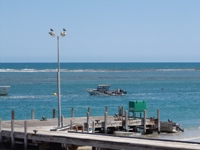
Australia So Much to See

In 1846 Augustus Gregory commanded his first exploration expedition, with a party including his brothers Francis and Henry, to the north of Perth in search of land suitable for agriculture. Gregory returned with glowing reports of good pastoral land and coal deposits in the mid west coastal region.
Gregory's party also made the first discovery of coal in Western Australia, on the Irwin River gorge which is now known as Coalseam Conservation Park, Mingenew.
This was followed in 1848 with further exploration seeking further pastoral land and the mapping of the Gascoyne and Muchison Rivers. It was on this expedition that Lead ore was first found in the bed of the Murchison River by Pemberton Walcott, a member of Augustus Gregory's party.
These discoveries lead to the opening up of the Mid West, and the resulting establishment of a port and town at Champion Bay, now known as Geraldton.
In 1854, Gregory was chosen to lead a scientific exploration across the north of Australia. In what is now the Northern Territory, the party explored the Victoria River and followed Sturts Creek for 300 miles (483 kilometres) to where it disappeared into the Western Australian desert. The group also explored the Elsey, Roper and Macarthur Rivers.
In Queensland, Gregory named the Leichhardt River, and explored the Flinders, Burdekin, Fitzroy and Burnett Rivers. Following his exploration, pastoral areas were opened up in the north.
Gregory was awarded the gold medal of the Royal Geographical Society following this exploration.
1857 Gregory was hired by the government of New South Wales to search for traces of Ludwig Leichhardt, a fellow explorer who had disappeared
on an earlier expedition.
In 1848 Leichhardt again set out from the Condamine River to reach the Swan River. The expedition
consisted of Leichhardt, four Europeans, two Aboriginal guides, seven horses, 20 mules and 50 bullocks. He was last seen on 3 April
1848 at McPherson's Station, Coogoon, on the Darling Downs. His disappearance after moving inland, although investigated by many,
remains a mystery. The expedition had been expected to take two to three years, but after no sign or word was received from Leichhardt
it was assumed that he and the others in the party had died. The latest evidence suggests that they may have perished somewhere in
the Great Sandy Desert of the Australian interior.[2]
After finding traces of the lost explorer, Gregory was
forced by drought to abandon the search, and travelled south to Adelaide. This was his last major expedition.
Places named after explorer Augustus Gregory include
Port Gregory, on the coast to the west of Northampton
Mount Augustus, the largest rock in the southern hemisphere, was named after Augustus Gregory by his brother Francis Gregory.
He marked the southern boundary of the new colony of Queensland and in 1859 became its first commissioner for crown lands and surveyor-general.
Use your browser back button to return to the page you were reading

